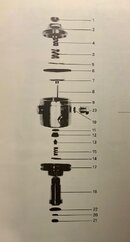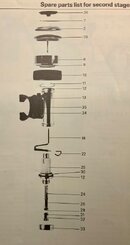"Cracking effort" for an Xstream is a bit of a misnomer. If you read the tuning instructions carefully, they specify 28-40mm (1.1-1.6"WC) during a very light inhalation. This is actually dynamic inhalation resistance. When Appendix C used to contain all the engineering data (it has since been reworded), the resistance was during "Q" flow, or 2 lpm. That's a very light inhalation indeed!
True cracking effort, or servo valve opening, actually occurs around .8"/20 mm when dynamic inhalation resistance is 25-30 mm. You can hear it hiss lightly, then as you suck a little harder, the valve suddenly "delivers". Typically on a magnehelic, you'll pop effort up to 1.5" for a fraction of a second, and then gas delivery and work of breathing immediately drops to the 1.2" level.
What's happening is that with minimal inhalation effort, the diaphragm curves inward and the servo valve begins to tilt. The first stage IP can easily keep up with that servo leak, so while you can hear it, the servo compartment does not depressurize, the valve insert does not collapse, and the valve does not open. But you've already reached classical "cracking effort". As you suck a little harder, the leak out of the servo increases, and now, due to the restriction inside the valve insert top, the servo compartment can't keep up. It depressurizes, and when servo compartment pressure becomes significantly less than IP, the valve insert collapses and true gas flow begins.

Setting inhalation effort on the Xstream is truly a matter of fractions of a millimeter. If you now add in an off-center servo valve stem due to mishandling of this $70 component, you realize why folks get frustrated. It becomes impossible to tune smoothly, and the reg gets a bad reputation. But also as usual, it's not the reg's fault, but the ham-fisted technician that bent the expensive servo last time around.
Actual tuning of a sound second stage is the essence of simplicity, and all the stories of "difficult service" are just unfamiliarity. It's a very elegant, but different design.
The reason they can breathe abruptly is not a second stage problem, but a first stage IP issue. Higher than 123 psi, the collapse of the valve insert and onset of gas flow is more sudden when the servo compartment drops to ambient. At a lower IP (109-123), things are much smoother. Using a higher cracking effort may mask it, but the real issue is too high an IP.
One final factor is depth. At an IP of 8.5 bar, gas expansion at the second stage valve is 8.5x at the surface! But at 99 feet (4 bar), 8.5 + 4 is 12.5 bar absolute IP, and 12.5/4 is only a 3.1x expansion. This reg breathes delightfully where it counts, at depth!
There's a reason so many of the world's militaries use the Xstream.
True cracking effort, or servo valve opening, actually occurs around .8"/20 mm when dynamic inhalation resistance is 25-30 mm. You can hear it hiss lightly, then as you suck a little harder, the valve suddenly "delivers". Typically on a magnehelic, you'll pop effort up to 1.5" for a fraction of a second, and then gas delivery and work of breathing immediately drops to the 1.2" level.
What's happening is that with minimal inhalation effort, the diaphragm curves inward and the servo valve begins to tilt. The first stage IP can easily keep up with that servo leak, so while you can hear it, the servo compartment does not depressurize, the valve insert does not collapse, and the valve does not open. But you've already reached classical "cracking effort". As you suck a little harder, the leak out of the servo increases, and now, due to the restriction inside the valve insert top, the servo compartment can't keep up. It depressurizes, and when servo compartment pressure becomes significantly less than IP, the valve insert collapses and true gas flow begins.
Setting inhalation effort on the Xstream is truly a matter of fractions of a millimeter. If you now add in an off-center servo valve stem due to mishandling of this $70 component, you realize why folks get frustrated. It becomes impossible to tune smoothly, and the reg gets a bad reputation. But also as usual, it's not the reg's fault, but the ham-fisted technician that bent the expensive servo last time around.
Actual tuning of a sound second stage is the essence of simplicity, and all the stories of "difficult service" are just unfamiliarity. It's a very elegant, but different design.
The reason they can breathe abruptly is not a second stage problem, but a first stage IP issue. Higher than 123 psi, the collapse of the valve insert and onset of gas flow is more sudden when the servo compartment drops to ambient. At a lower IP (109-123), things are much smoother. Using a higher cracking effort may mask it, but the real issue is too high an IP.
One final factor is depth. At an IP of 8.5 bar, gas expansion at the second stage valve is 8.5x at the surface! But at 99 feet (4 bar), 8.5 + 4 is 12.5 bar absolute IP, and 12.5/4 is only a 3.1x expansion. This reg breathes delightfully where it counts, at depth!
There's a reason so many of the world's militaries use the Xstream.





